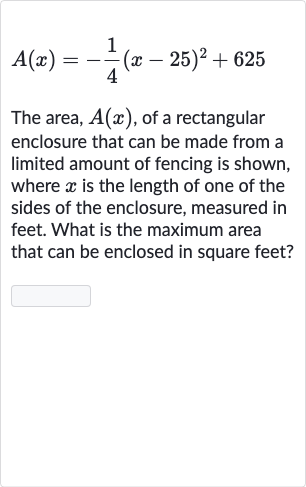Full solution
Q. The area, , of a rectangular enclosure that can be made from a limited amount of fencing is shown, where is the length of one of the sides of the enclosure, measured in feet. What is the maximum area that can be enclosed in square feet?
- Identify Parabola Form: We are given the function , which represents the area of a rectangular enclosure. To find the maximum area, we need to find the vertex of the parabola represented by this function, as it is a downward-opening parabola (indicated by the negative coefficient of the squared term).
- Find Vertex Coordinates: The function is in the form of a quadratic equation , where is the vertex of the parabola. In this case, and . Since the coefficient is negative, the vertex represents the maximum point of the parabola.
- Calculate Maximum Area: The maximum area that can be enclosed is the value of at the vertex. Since we have identified the vertex as , the maximum area is , which is square feet.
- No Derivatives Needed: We do not need to take any derivatives or set the derivative equal to zero because the vertex form of the quadratic function directly gives us the maximum value for this downward-opening parabola.
More problems from GCF and LCM: word problems
QuestionGet tutor help
QuestionGet tutor help

